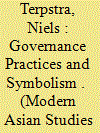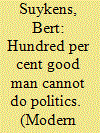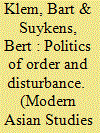|
|
|
Sort Order |
|
|
|
Items / Page
|
|
|
|
|
|
|
| Srl | Item |
| 1 |
ID:
160167


|
|
|
|
|
| Summary/Abstract |
Over the length of its current tenure, Punjab's Shiromani Akali Dal (SAD) has sought to become more a socially inclusive party, more responsive to popular demands, and even to improve service delivery and eradicate corruption. However, despite these lofty goals, it has also presided over what people refer to as ‘goonda raj’—a rule of thugs—and has managed to alienate large sections of the population and, in the process, fuelled the rise of the anti-corruption Aam Admi Party in the state. In this article, based on ethnographic fieldwork in rural Malwa, I attempt to shed light on the roots of this contradiction. Is it simply the case, as ordinary people allege, that the SAD's claims are empty and that its members are merely interested in looting the state? Or, alternatively, is it the case that the party merely operates in accordance with Punjab's allegedly time-honoured tradition of rival factions competing to appropriate the spoils of power? I suggest instead that much of the corruption and violence observable at the village level in Punjab has its roots in the antagonistic relationship between the Congress Party and the Shiromani Akali Dal. It is this antagonism that appears to fuel the SAD's highly partisan form of government, and it is partisan government that appears to fuel the corruption and the village-level factional conflict that is documented in this article.
|
|
|
|
|
|
|
|
|
|
|
|
|
|
|
|
| 2 |
ID:
160164


|
|
|
|
|
| Summary/Abstract |
Questions of state formation and public authority have been at the top of the development and political agenda in Nepal since 2006. The post-2006 so-called ‘political transition’ has been characterized by rising ethnic tensions, violence, strikes, and a bewildering kaleidoscope of leaders gaining political leverage, only to be marginalized again. In 2015, the Constitution was finally adopted following the earthquakes and amid violent protests from groups who felt their needs were marginalized in the final version. In this article we are concerned to probe how struggles over different technologies of government help throw into relief the various terrains within which public authority is claimed and contested, and, as a result, help to expose the limits of the state. Using the forestry sector as an ethnographic lens, we argue that there is both a profound failure by the state to provide services and stable governance as well as an ability to reproduce itself and to function in some contexts. It is therefore important to understand public authority during this period as both stable and unstable—and at times, instability is what helps to perpetuate particular imaginaries of the Nepali state.
|
|
|
|
|
|
|
|
|
|
|
|
|
|
|
|
| 3 |
ID:
160170


|
|
|
|
|
| Summary/Abstract |
Youth frustration was a front-running issue during Nepal's decade-long civil war (1996–2006) and democratic protests (2003–2006). Young activists were mobilized as foot soldiers in these political battles, but they also capitalized on their position to establish themselves politically. They earned public recognition for their direct action; however, they have struggled to stay relevant as their parties shifted from protesting against the government to running the government. In response, youth activists leveraged the public support they earned and general concern over youth disenfranchisement to demand an active role in state restructuring. The Maoist-majority Constituent Assembly government partially heeded them by handing over the task of drafting the National Youth Policy to their youth wings and other youth activists. This policy shaped the youth-focused agenda of the newly designed Ministry of Youth and Sports and other government bureaus. This article uses the National Youth Policy as the context for an examination of how youth activists are establishing public authority beyond (violent) protest. By focusing on the micro-politics of the committee appointed to draft the Policy, I analyse the techniques its members used to assert their political values and agendas through policymaking in order to secure their positions during politically turbulent times. This article elucidates how formalized governing practices and revolutionary politics blend to reconstitute state order in the aftermath of civil war.
|
|
|
|
|
|
|
|
|
|
|
|
|
|
|
|
| 4 |
ID:
160168


|
|
|
|
|
| Summary/Abstract |
This article explores how local civil servants produce the conditions of possibility for bureaucratic authority in Nepal's contested political environment of war and post-war ‘transition’. Specifically, it examines the everyday practices of local civil servants as they attempt to influence the distribution of such public resources as agricultural inputs and local government budgets. The article asks: how do local civil servants produce the authority necessary to get things done in the face of changing local government structures and rival authority claims from both wartime Maoist People's Governments and resurgent patronage politics in the post-war period? In a context characterized as ‘ordinary extraordinary’, the article suggests that local civil servants employ a form of practice that has been termed ‘tactical government’ and proposes three distinct forms of this practice. However, the article also argues that tactical practice tells only part of the story and that it can be insightful to enrich our understanding of tactical government with an analysis of more general life projects. Bureaucratic practices are also motivated by factors such as the significance of the contested resource and paternal ideas of ‘the common good’. Such a suggestion is in line with recent work on everyday lives in situations of protracted violent conflict and insecurity, and on the role of culture in producing civil servants/services. Looking at these two forms of practice together, in particular their interconnections, gives us a fuller account of how authority is produced. Furthermore, it allows more nuanced and detailed perspectives into the complex process of state-making.
|
|
|
|
|
|
|
|
|
|
|
|
|
|
|
|
| 5 |
ID:
160169


|
|
|
|
|
| Summary/Abstract |
This article focuses on how the Liberation Tigers of Tamil Eelam (LTTE) insurgency performed de facto sovereignty and public authority in Northeastern Sri Lanka. It is situated within the wider academic debate on governance by state and non-state actors. We venture to unravel the complex linkages between the LTTE's governance practices and legitimation strategies by looking at narratives, performances, and inscriptions. While monopolizing the justice and policing sectors, in other sectors the LTTE operated pragmatically in conjunction with the state. The organization tried to generate and sustain public authority and legitimacy through a variety of violent and non-violent practices and symbols. It ‘mimicked’ statehood by deploying, among others, policing, uniforms, ceremonies, nationalist songs, commemorations of combatants, and the media. This not only consolidated its grip on the Northeast, but also engineered a level of support and compliance. We conclude that the LTTE's governance included practices that were created and carried out independently from the Sri Lankan state, while others took shape within a pre-existing political order and service provision by the state. The article elucidates the LTTE's mimicry of the state, as well as the operation of parallel structures and hybrid forms of state-LTTE collaboration. This facilitates a nuanced understanding of rebel governance beyond a simple state versus non-state binary.
|
|
|
|
|
|
|
|
|
|
|
|
|
|
|
|
| 6 |
ID:
160165


|
|
|
|
|
| Summary/Abstract |
This article seeks to better understand political violence in Bangladesh. Analysing the case of student politics, the article enquires into the productive use of violence by student activists and leaders. It argues that student violence should not be considered as a breakdown of order or a sign of state fragility, but as a means of gaining access to party-state resources and patronage. Violence operates to mark out and maintain power relations between student groups and factions. Risk-taking and the performance of self-sacrifice are important to delineate spaces of power and broker connections to potential political patrons. While actively engaging in political violence provides legitimacy within student hierarchies, victimhood provides a powerful means of publicly displaying one's commitment to a political party. Student public authority, while violent, is closely integrated in national political-party authority structures and, as a result, is intrinsically connected to the Bangladesh party-state. While it might seem counter-intuitive, this article argues that the use of political violence helps one to gain protection from the (party-)state.
|
|
|
|
|
|
|
|
|
|
|
|
|
|
|
|
| 7 |
ID:
160161


|
|
|
| 8 |
ID:
160163


|
|
|
|
|
| Summary/Abstract |
In 1968 a popular movement emerged on the streets of Pakistan which toppled the regime of General Muhammad Ayub Khan and ushered in the Pakistan People's Party (PPP). After a decade of military rule this movement was heralded as a turning point in the country's political fortunes. However, the war in 1971, the failure of the PPP to live up to its radical slogans, and Pakistan's eventual return to military rule in 1977 were seen as clear indications of the failure of both the movement and the PPP. This article focuses on the area of Kot Lakhpat in Lahore and the emergence of a worker-led court under Abdur Rehman to argue that this narrative of the failure of the movement does not leave space for local success stories which, while temporary, had an important impact on the role that the working classes imagined for themselves within the state. The Kot Lakhpat movement was part of a longer history of labour politics, and its story challenges the centrality of the PPP and shows how local structures of authority can be formed in response to the greater space for radical action opened up by a wider national resistance movement.
|
|
|
|
|
|
|
|
|
|
|
|
|
|
|
|
| 9 |
ID:
160162


|
|
|
|
|
| Summary/Abstract |
In this article, we compare two kinds of public authority under conditions of civil war. We study two villages in eastern Sri Lanka, both of which came under LTTE rule during the 1990s and 2000s. The first case study describes a rural development society, which was co-opted by the LTTE to rule the village. The second describes the leaders of a Hindu temple, who defied LTTE attempts to settle temple-related conflicts. Conceptually, we draw on the notion of the public sphere as a space of encounter between the rulers and the ruled. This perspective helps us come to grips with the convoluted political landscape of war. Our two case studies suggest that public authority and sovereignty are mutually constituted. We argue that both forms of power are reworked in the encounter with the public sphere. A sovereign aspirant like the LTTE does not simply impose itself on society, it encroaches on it. This involves contingent efforts of reigning in other forms of public authority, some of which are more defiant than others. Conversely, public authority not only derives validity from sovereign endorsement, but from contestations around sovereignty as well.
|
|
|
|
|
|
|
|
|
|
|
|
|
|
|
|
| 10 |
ID:
160166


|
|
|
|
|
| Summary/Abstract |
This article explores the politics of surveillance, suppression, and resistance within a women's correctional facility in 1970s Calcutta, a city in eastern India. I highlight the excessively violent treatment of women political prisoners, who were captured and tortured for their active participation in a Maoist guerrilla (Naxal) movement. I argue that the state officials who formed the lowest rung of the government's machinery to supress the movement—the police, prison guards, and wardens—partially usurped these carceral worlds during conditions of social unrest to create small regimes of de facto sovereignty over prison publics. During that critical period in the history of political uprising in the region, the central government coercively implemented a series of ‘constitutional actions’ in the name of internal security threats and withdrew civil liberties from Indian citizens. Political opponents were captured and imprisoned, and prisons became a space for licensed excess. I show how women political prisoners cooperated and conspired with women convicts (the latter having nurtured their own coping skills and structures to deal with persecution and negligence while in the detention system) to develop multiple forms of resistance to the extra-legal use of authority in prison, especially in the context of a volatile socio-political environment in the city.
|
|
|
|
|
|
|
|
|
|
|
|
|
|
|
|
| 11 |
ID:
160171


|
|
|
|
|
| Summary/Abstract |
In this Afterword I argue that public authority in South Asia is produced in a dynamic interplay between ever-more segmented publics and the ubiquity of highly performative violence. Drawing on Indian examples, I suggest that the success of vernacular publics in producing a sense of cultural intimacy within language communities in turn has prompted a new segmentation of publics. This has occurred along lines of caste and community, defined by social experience and symbols, rather than language as such. The concomitant routinization of violence in public life—whether as physical destruction of public property, attacks on other communities, or as symbolic elevations of victims of violence to the status of martyrs—indicate that today valorization and experiences of violence, however incommensurable, have emerged as a universal medium, or general equivalent, in public and political life in India.
|
|
|
|
|
|
|
|
|
|
|
|
|
|
|
|
|
|
|
|
|